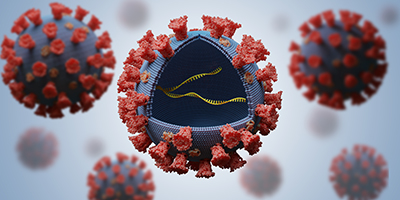VIR-CLASP reveals new insights into mobile mechanisms of
[ad_1]
By Brad Davidson

RNA viruses invade cells and co-opt mobile equipment to copy and translate their genomic materials. To stave off an infection till immune cells arrive, host cells depend on “intrinsic immunity components” corresponding to proteins already current inside the cell. By way of the speedy binding of intrinsic immunity components, host cells would possibly forestall a virus from organising store. Though this primary contact between host cells and a viruses could possibly be important for stopping an infection, the molecules that comprise intrinsic immunity have been largely understudied—till just lately.
Beforehand developed laboratory methods can reveal mobile components that work together with RNA virus genomes upon an infection, however none particularly goal early interactors. In Molecular Cell, the lab of Manny Ascano, an assistant professor of biochemistry, reviews VIR-CLASP, a novel approach to assist researchers analyze and evaluate intrinsic immunity components that work together with completely different RNA viruses.
Step one of VIR-CLASP captures pre-labeled viral RNA from contaminated cells together with any proteins connected to it. Then, mass spectrometry identifies these proteins, creating an inventory of candidate intrinsic immunity components. Thisvirus goes unnoticed. Utilizing VIR-CLASP, the Ascano group found a whole bunch of host proteins that bind to the Chikungunya virus genome upon publicity. Forty p.c of those components have been beforehand unknown to bind to RNA.
The authors chosen a subset of proteins recognized by VIR-CLASP—together with YTHDF1 and FASN, amongst others—to characterize for his or her impact on CHIKV an infection. By modulating the expression of YTHDF1 in contaminated cells, the Ascano group confirmed that YTHDF1 binds CHIKV RNA and that its binding negatively correlates with virus manufacturing. Since proteins within the YTHDF household connect solely to an RNA modification often called m6A, the Ascano lab additionally discovered that m6A exists in CHIKV. Moreover, the staff confirmed that FASN unexpectedly associates with CHIKV RNA and by doing so spurs viral RNA replication. Earlier analysis described FASN’s position in regulating viral replication, however the mechanism by which it mediated this impact was regarded as fully based mostly on its enzymatic actions.
Whereas the identities of many intrinsic immunity components stay enigmatic, this research signifies that these beforehand unrecognized antiviral components can contribute to the result of an infection. Additional utility of VIR-CLASP might facilitate the identification of extra intrinsic immunity molecules in all kinds of viruses and situations. As new RNA viruses corresponding to SARS-CoV-2 come up, an understanding of things that promote or forestall preliminary an infection by methods corresponding to VIR-CLASP could possibly be important for establishing new therapeutics.
This analysis was supported by the Chemistry-Biology Interface/Chemical Biology of Infectious Illness coaching grants, the Nationwide Middle for Advancing Translational Sciences, the Nationwide Institutes of Well being, and the Vanderbilt College Division of Biochemistry.
[ad_2]
Supply hyperlink